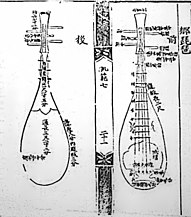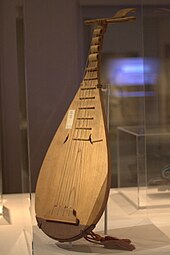Bipa


The bipa is a pear-shape lute that is a traditional Korean musical instrument. It has the same Central Asian roots as the Chinese pipa and was introduced through the Silk Road to Goguryeo and Silla. There are two major types of bipa: the four stringed dang-bipa (당비파 / 唐琵琶) and the five stringed hyang-bipa (향비파 / 鄕琵琶). While dang-bipa was a Tang-style pipa first introduced from the Chinese Tang dynasty and localized over time to have Korean characteristics, hyang-bipa was created in the Korean Kingdom of Silla. The instrument is also related to other derivatives such as Vietnamese đàn tỳ bà and the Japanese biwa.

The bipa was popular in court music until it fell out of use in the early 20th century during the Japanese Colonial period. In 1988/89, there was the first attempt to revive the two bipa that was unsuccessful in commercialization. This revived bipa used the existing modern Chinese pipa as a basis but was modified to the Korean form, and followed Joseon style and Chinese style use of fake nails and Chinese techniques. It also reintroduced the two sound holes on the front characteristic of the two Korean bipa as well as the five strings characteristic of the hyang-bipa. The strings used are of twisted silk, rather than the metal-nylon used for the Chinese pipa. Following this recreation, there were many reinvented modern bipa.
A more faithful restoration of the two bipa is used in contemporary traditional music. In 2007, restoration by National Gugak Center of South Korea followed closely to the two original bipa from Akhak-Gwebeom [1], not made like the Chinese pipa. This recreation uses silk strings and is plucked with bare fingers or with a stick. This is used for traditional music and sanjo.
External links[]
- Traditional Korean Music with pictures and descriptions of bipa
Notes[]
- ^ Professor (1936 - 2003) made an attempt in 1989
- Korean musical instruments
- Necked lutes
- Korea stubs
- Lute stubs